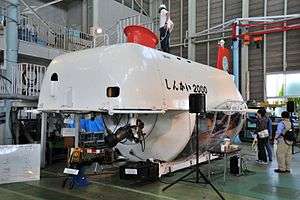DSV Shinkai 2000
The Shinkai 2000 (しんかい) is a manned research submersible that can dive up to a depth of 2,000 m. It was completed in 1981 and until 1991 it had the greatest depth range of any manned research vehicle in the Japan. The Shinkai 2000 is owned and run by the Japan Agency for Marine-Earth Science and Technology (JAMSTEC) and it is launched from the support vessel Natsushima.
 | |
| History | |
|---|---|
| Name: | Shinkai 2000 |
| Builder: | Mitsubishi Heavy Industries Kobe Shipyard |
| Cost: | 3.7billion (Japanese yen) |
| Laid down: | 1978 |
| Launched: | 1981 |
| Sponsored by: | JAMSTEC |
| Completed: | 1981 |
| Acquired: | 1981 |
| Commissioned: | 1981 |
| Decommissioned: | 2004 |
| Maiden voyage: | 1983 |
| In service: | 1983 |
| Out of service: | 2002 |
| Homeport: | Yokosuka |
| Fate: | Preserved at Shin Enoshima aquarium |
| General characteristics | |
| Type: | Deep-submergence vehicle |
| Length: | 9.3 m (31 ft) |
| Beam: | 2.9 m (9.5 ft) |
| Draft: | 3.0 m (9.8 ft) |
| Installed power: | electric motor |
| Speed: | 3.0 knots (5.6 km/h; 3.5 mph) |
| Endurance: | 80h |
| Test depth: | 2,000 m (6,600 ft) |
| Complement: | 3 |
Two pilots and one researcher operate within a 30 mm thick High-strength low-alloy steel pressure hull with an internal diameter of 2.2 m. Buoyancy is provided by syntactic foam.
Three methacrylate resin view ports are arranged at the front and on each side of the vehicle.
See also
- DSV Shinkai 6500 – Japanese manned research submersible that can dive up to a depth of 6,500 metres
References

- JAMSTEC Shinkai 2000 page
This article is issued from Wikipedia. The text is licensed under Creative Commons - Attribution - Sharealike. Additional terms may apply for the media files.